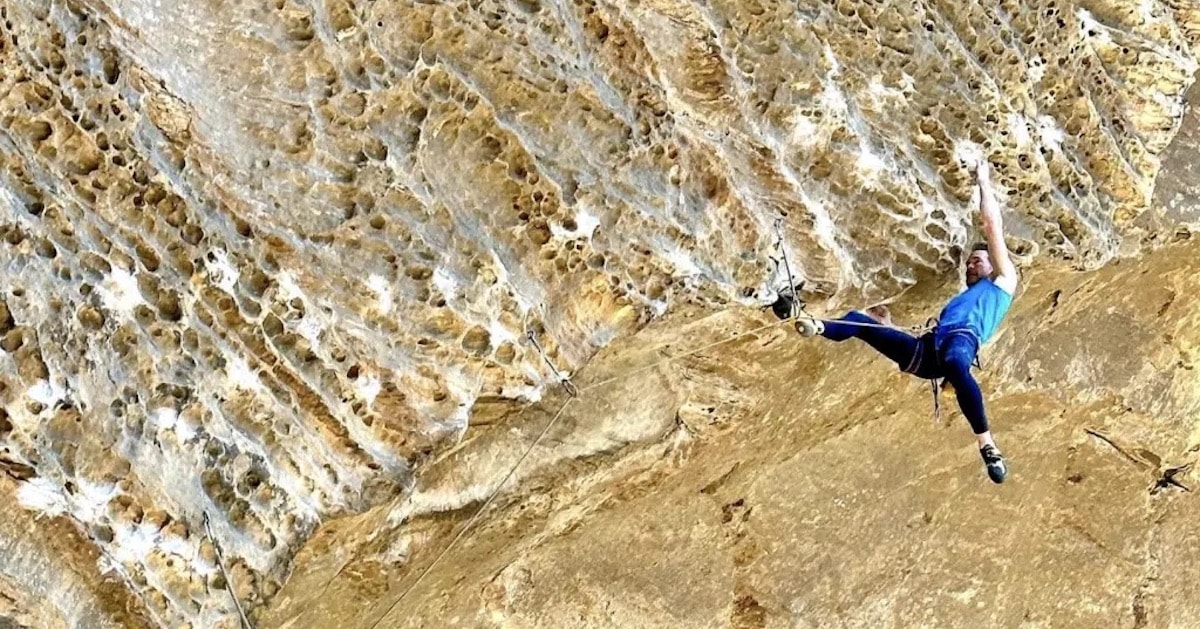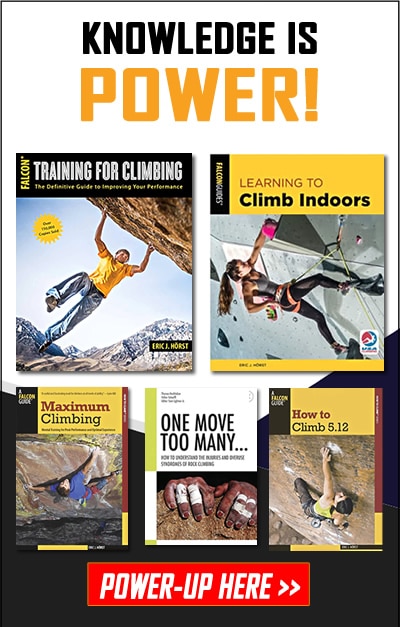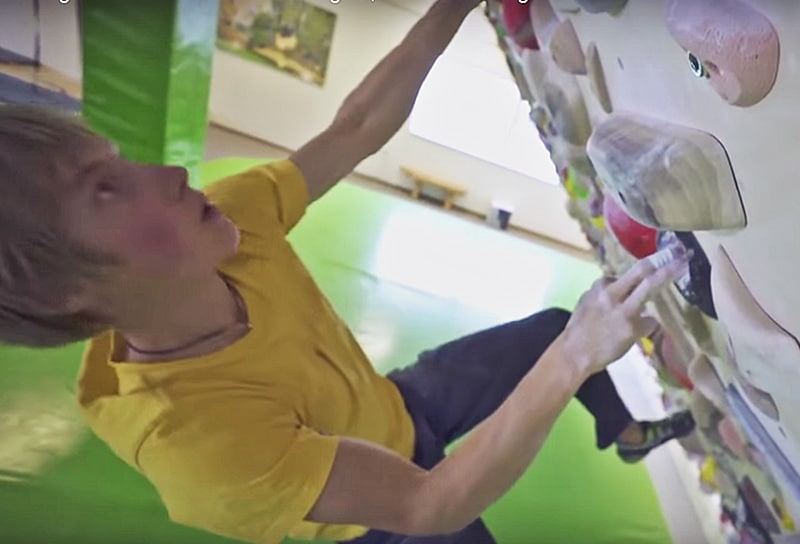If you find yourself at the crag feeling distracted, anxious, or nervous about your climb, then you will benefit from using these relaxation strategies to calm your brain and body!
Different climbs, situations, and personalities require different arousal levels for optimal performance. When you’re getting signs that you need to chill out in order to stay focused and follow through, you can learn how to turn down the dial just in time.
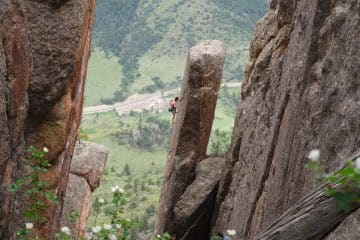
Delicate moves call for relaxation strategies to stay present, careful, and focused.
Diaphragmatic Breathing
This one seems like a gimme, but truly deep breathing isn’t as simple as it seems. Shallow breaths that engage just the top of your torso ultimately increase body tension. Your muscles don’t receive enough oxygen to perform at their best, while your mind believes that the situation is too dire to even think about taking a full breath.
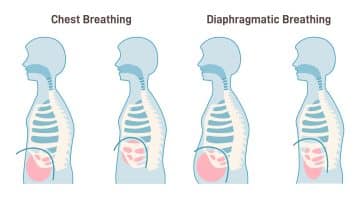
Engage your diaphragm for belly breaths that send relaxation signals throughout your whole body.
Utilizing the full capacity of your lungs increases the flow of oxygen from your core to your limbs. It also convinces your body that it’s not actually in danger. Belly breathing, or diaphragmatic breathing, engages the deeper parts of your respiratory system. Inhale through your nose and focus on slowly drawing air into your chest and then down toward your belly. When practicing deep breathing off the wall, use your lower abdomen as a metric: watch it physically expand to make sure you’re sending the breath all the way down.
Exhale the breath slowly through pursed lips. The exhale should take several seconds longer than the inhale; it’s the extended release that gives your mind a signal to ease out of crisis mode. Exhalations tap into the parasympathetic nervous system that regulates rest and relaxation, so spending more time on this half of the breath drives the message home.
Practice these deep breaths on the wall before and after hard moves to reground yourself. Cruxes might naturally take your breath away, but it’s important to return to baseline as soon as possible so you don’t get stuck in the stress cycle.
Pro tip: Take a few deep belly breaths at every shakeout and rest position!
Calming Visualization
You can use mental images to familiarize yourself with the climb even when you’re not on it. This helps take away some of the stress associated with strangeness. Picture the climb down to each individual hold, repeatedly running through the sequence in your mind until you’re sure of every step. Think about details like the color of the rock, the way it catches the light, how it feels on your skin, and even the smell of your surroundings. Mentally move through the climb before you hop on, after you finish up an attempt, and during down time throughout your day. The better you acquaint yourself with the sequence, the less you’ll have to actively keep track of while you’re climbing so your instincts can take the wheel.
This works for individual moves as well. Beyond just creating a mental map of the climb, you can prepare yourself for how certain maneuvers feel in your body so that executing them feels more natural in the moment. You’re more likely to land a precise deadpoint, trust a delicate smear, or seek out a stem rest when you have a clear understanding of what that position or move looks – and feels – like to executel. Make note of exactly where your limbs need to end up in order for the move to work. Then, visualize the specific muscles you need to either tighten or relax to navigate the move efficiently.
Alternatively, you can visualize yourself in a different place of calm when the stress of the climb rises too high. Prepare a simple mental image ahead of time that calls back a relaxing memory: laughing with a good friend, sitting by a trickling stream, listening to a crackling campfire, etc. Flesh out your calm place with details from all your senses so you can capture exactly how this moment looks, sounds, feels, tastes, and smells. Take this image with you on the climb to pull out in tandem with deep breaths for a rapid refresh.
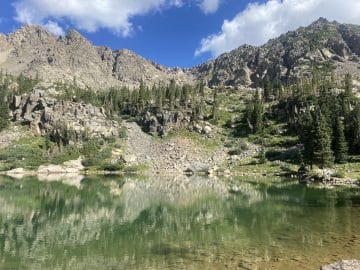
Picture the kind of place that slows your heart rate and streamlines your train of thought.
Instructional Self-Talk
Stop wandering thoughts and catastrophizing by narrating your movements. Tell yourself exactly what to do as you’re doing it, or pretend to describe the process to someone who can’t see it. This tactic of putting words to your actions is powerful–it will help block out distracting thoughts and sharpen your focus on the move at hand.
The ANSWER Sequence
Here’s an effective six-step relaxation protocol to get re-centered quickly. You can employ it anytime you feel anxious or stressed, whether you’re at the crag, office, or on the freeway!
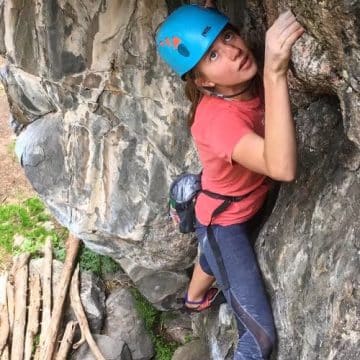
Run through the ANSWER sequence in rest positions to stay grounded in between cruxes.
1. Awareness of tension and anxiety: Check for signs of stress rising anywhere in your body or mind. This way, you can catch any negative changes before they hurt your performance.
2. Normalize breathing: Monitor your breath rate to make sure you’re practicing deep, even breaths throughout the climb. You might hold your breath for more core tension during a hard move, but always try to return to the regular pattern.
3. Scan for specific tension spots: Do a quick sweep of your muscles to find tightness, especially in the forearms, shoulders, chest, abdominals, and calves. Then release the tightness by first fully contracting then relaxing the muscle. Try visualizing the tension flowing out like air from a balloon.
4. Wave of relaxation: With a breath, send a wave down your whole body from head to toe.
5. Erase thoughts that don’t matter: You can’t do anything about what happened in the last move or control the outcome of the next. Focus on climbing at your best right now.
6. Reset posture and attitude: Straighten up and smile. Enjoy the amazing moment that you’re in!
Related Articles:
- Climb Better by Optimizing Your Arousal and Energy Levels
- Excitation Strategies for Amped and Energized Climbing
- 10 Mental Strategies to Improve Performance…In Climbing and Beyond!
- Increasing Self-Awareness in the Pursuit of Excellence
- 10 Tips for Pursuing Maximum Climbing Performance
Copyright © 2022 Lucie Hanes & Hörst Training LLC | All Rights Reserved.

